服务心跳
Nacos Client会维护一个定时任务通过持续调用服务端的接口更新心跳时间,保证自己处于存活状态,防止服务端将服务剔除,Nacos默认5秒向服务端发送一次,通过请求服务端接口/instance/beat发送心跳。
客户端服务在注册服务的时候会增加一个心跳的任务,如下图所示:

首先看下BeatInfo这个类,重点看标注的字段,该字段是给周期任务设定时间,如下图:

该方法内部定义的一个DEFAULT_HEART_BEAT_INTERVAL的常量,设定5秒:

接下来我们看下addBeatInfo方法,该方法内部主要是将BeatTask任务加入到线程池ScheduledExecutorService当中,如下图:

重点部分就是看BeatTask,BeatTask继承Runnable,run方法就是我们的重点,该方法调用了NamingProxy的sendBeat方法,服务端请求地址为/instance/beat的方法
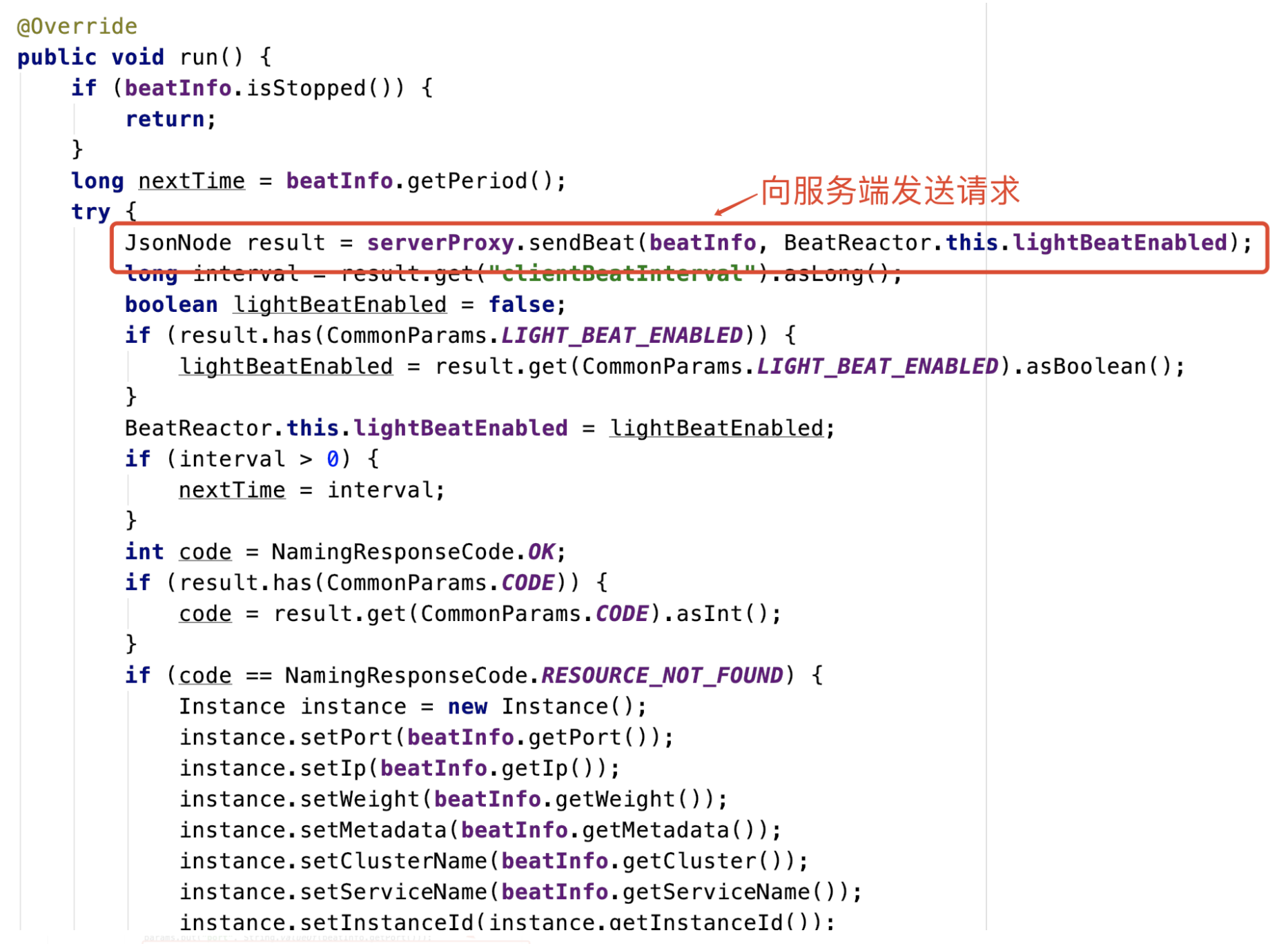
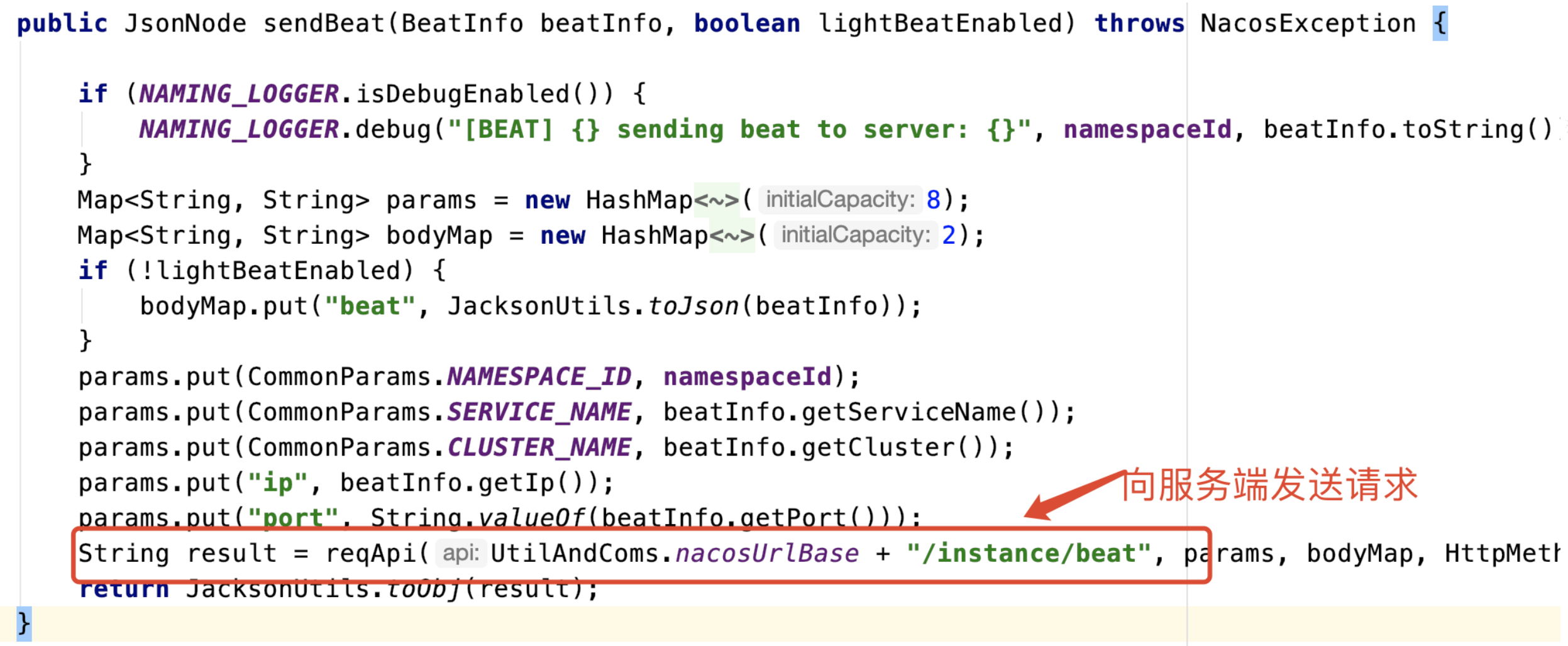
接下来我们把目光放到服务端,找到InstanceController的beat方法,如果是参数beat信息的话,说明是第一次发起心跳,则会带有服务实例信息,因为发起心跳成功则服务端会返回下次不要带beat信息的参数,这样客户端第二次就不会携带beat信息了。如果发现没有该服务,又没带beat信息,说明这个服务可能被移除过了,直接返回没找到。如果没有服务,但是发现有beat信息,那就从beat中获取服务实例信息,进行注册,整体执行流程如下图:

@CanDistro @PutMapping("/beat") @Secured(parser = NamingResourceParser.class, action = ActionTypes.WRITE) public ObjectNode beat(HttpServletRequest request) throws Exception { ObjectNode result = JacksonUtils.createEmptyJsonNode(); //设置心跳间隔 result.put(SwitchEntry.CLIENT_BEAT_INTERVAL, switchDomain.getClientBeatInterval()); String beat = WebUtils.optional(request, "beat", StringUtils.EMPTY); RsInfo clientBeat = null; //判断有无心跳内容 //如果存在心跳内容则不是轻量级心跳就转化为RsInfo if (StringUtils.isNotBlank(beat)) { clientBeat = JacksonUtils.toObj(beat, RsInfo.class); } String clusterName = WebUtils .optional(request, CommonParams.CLUSTER_NAME, UtilsAndCommons.DEFAULT_CLUSTER_NAME); String ip = WebUtils.optional(request, "ip", StringUtils.EMPTY); int port = Integer.parseInt(WebUtils.optional(request, "port", "0")); if (clientBeat != null) { if (StringUtils.isNotBlank(clientBeat.getCluster())) { clusterName = clientBeat.getCluster(); } else { // fix #2533 clientBeat.setCluster(clusterName); } ip = clientBeat.getIp(); port = clientBeat.getPort(); } String namespaceId = WebUtils.optional(request, CommonParams.NAMESPACE_ID, Constants.DEFAULT_NAMESPACE_ID); String serviceName = WebUtils.required(request, CommonParams.SERVICE_NAME); NamingUtils.checkServiceNameFormat(serviceName); Loggers.SRV_LOG.debug("[CLIENT-BEAT] full arguments: beat: {}, serviceName: {}", clientBeat, serviceName); //获取实例的信息 Instance instance = serviceManager.getInstance(namespaceId, serviceName, clusterName, ip, port); //如果实例不存在 if (instance == null) { if (clientBeat == null) { result.put(CommonParams.CODE, NamingResponseCode.RESOURCE_NOT_FOUND); return result; } Loggers.SRV_LOG.warn("[CLIENT-BEAT] The instance has been removed for health mechanism, " + "perform data compensation operations, beat: {}, serviceName: {}", clientBeat, serviceName); //根据您心跳内容创建一个实例信息 instance = new Instance(); instance.setPort(clientBeat.getPort()); instance.setIp(clientBeat.getIp()); instance.setWeight(clientBeat.getWeight()); instance.setMetadata(clientBeat.getMetadata()); instance.setClusterName(clusterName); instance.setServiceName(serviceName); instance.setInstanceId(instance.getInstanceId()); instance.setEphemeral(clientBeat.isEphemeral()); //注册实例 serviceManager.registerInstance(namespaceId, serviceName, instance); } //获取服务的信息 Service service = serviceManager.getService(namespaceId, serviceName); if (service == null) { throw new NacosException(NacosException.SERVER_ERROR, "service not found: " + serviceName + "@" + namespaceId); } //不存在的话,要创建一个进行处理 if (clientBeat == null) { clientBeat = new RsInfo(); clientBeat.setIp(ip); clientBeat.setPort(port); clientBeat.setCluster(clusterName); } //开启心跳检查任务 service.processClientBeat(clientBeat); result.put(CommonParams.CODE, NamingResponseCode.OK); //5秒间隔 if (instance.containsMetadata(PreservedMetadataKeys.HEART_BEAT_INTERVAL)) { result.put(SwitchEntry.CLIENT_BEAT_INTERVAL, instance.getInstanceHeartBeatInterval()); } //告诉客户端不需要带上心跳信息了,变成轻量级心跳了 result.put(SwitchEntry.LIGHT_BEAT_ENABLED, switchDomain.isLightBeatEnabled()); return result; }
接下来我们看一下processClientBeat方法,该方法将ClientBeatProcessor放入到线程池中,接下来我们看下重点看下run方法,

该方法内部主要就是更新对应实例下心跳时间,整体上如下图:
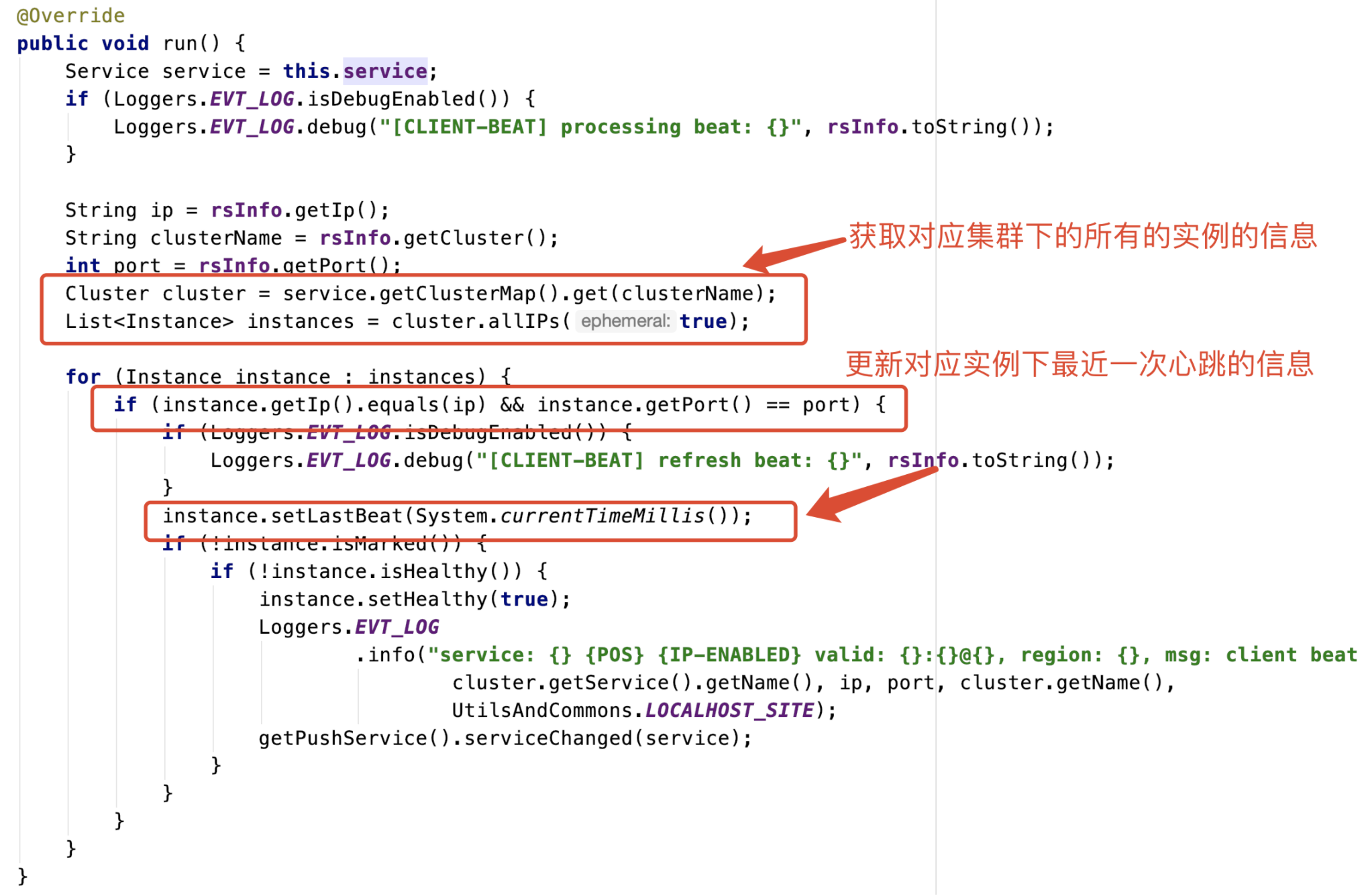
至此完成了从客户端到服务端更新实例的心跳时间,下图是整体的时序图:

服务的健康检查
Nacos Server会开启一个定时任务来检查注册服务的健康情况,对于超过15秒没收到客户端的心跳实例会将它的 healthy属性置为false,此时当客户端不会将该实例的信息发现,如果某个服务的实例超过30秒没收到心跳,则剔除该实例,如果剔除的实例恢复,发送心跳则会恢复。
当有实例注册的时候,我们会看到有个service.init()的方法,该方法的实现主要是将ClientBeatCheckTask加入到线程池当中,如下图:

ClientBeatCheckTask中的run方法主要做两件事心跳时间超过15秒则设置该实例信息为不健康状况和心跳时间超过30秒则删除该实例信息,如下代码:

public void run() { try { if (!getDistroMapper().responsible(service.getName())) { return; } if (!getSwitchDomain().isHealthCheckEnabled()) { return; } //获取服务所有实例信息 List<Instance> instances = service.allIPs(true); // first set health status of instances: for (Instance instance : instances) { //如果心跳时间超过15秒则设置该实例信息为不健康状况 if (System.currentTimeMillis() - instance.getLastBeat() > instance.getInstanceHeartBeatTimeOut()) { if (!instance.isMarked()) { if (instance.isHealthy()) { instance.setHealthy(false); Loggers.EVT_LOG .info("{POS} {IP-DISABLED} valid: {}:{}@{}@{}, region: {}, msg: client timeout after {}, last beat: {}", instance.getIp(), instance.getPort(), instance.getClusterName(), service.getName(), UtilsAndCommons.LOCALHOST_SITE, instance.getInstanceHeartBeatTimeOut(), instance.getLastBeat()); getPushService().serviceChanged(service); ApplicationUtils.publishEvent(new InstanceHeartbeatTimeoutEvent(this, instance)); } } } } if (!getGlobalConfig().isExpireInstance()) { return; } // then remove obsolete instances: for (Instance instance : instances) { if (instance.isMarked()) { continue; } //如果心跳时间超过30秒则删除该实例信息 if (System.currentTimeMillis() - instance.getLastBeat() > instance.getIpDeleteTimeout()) { // delete instance Loggers.SRV_LOG.info("[AUTO-DELETE-IP] service: {}, ip: {}", service.getName(), JacksonUtils.toJson(instance)); deleteIp(instance); } } } catch (Exception e) { Loggers.SRV_LOG.warn("Exception while processing client beat time out.", e); } }
首先我们来看一下deleteIp方法,该方法内部主要通过构建删除请求,发送删除请求,如下图:

删除实例的接口如下图:
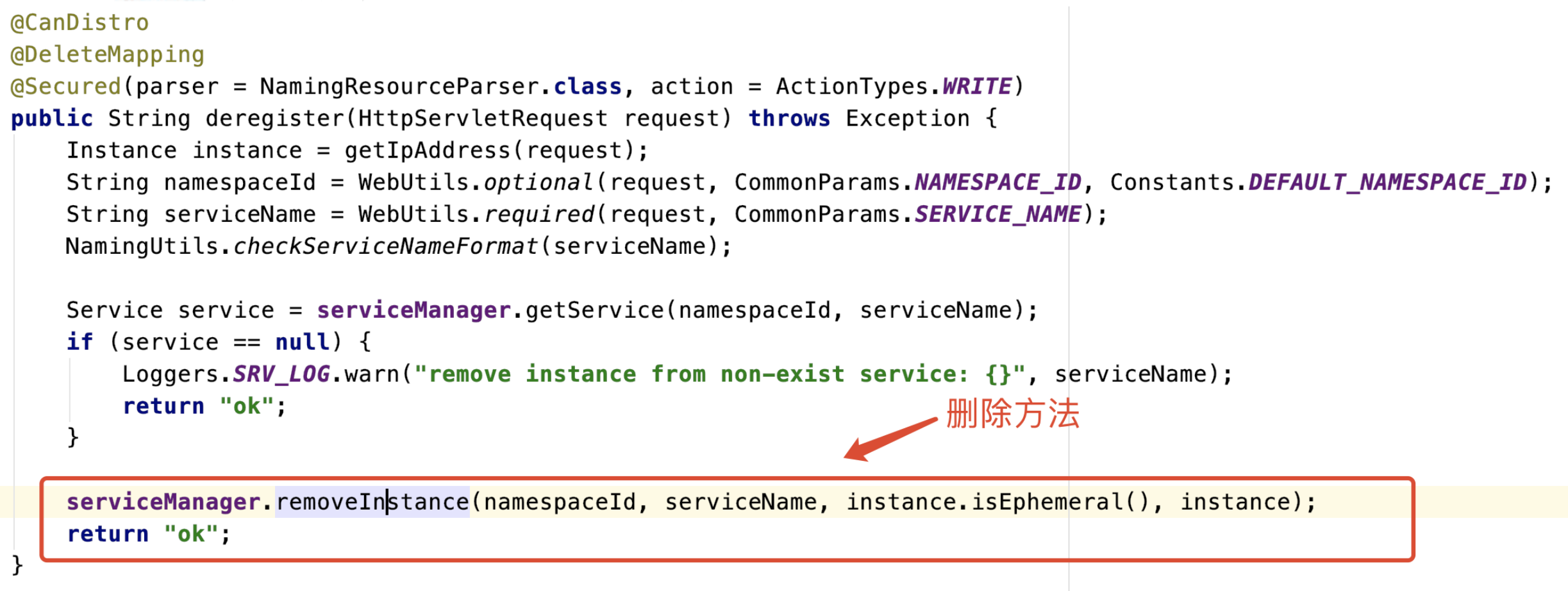
内部通过调用ServiceManager的removeInstance方法,如下图:
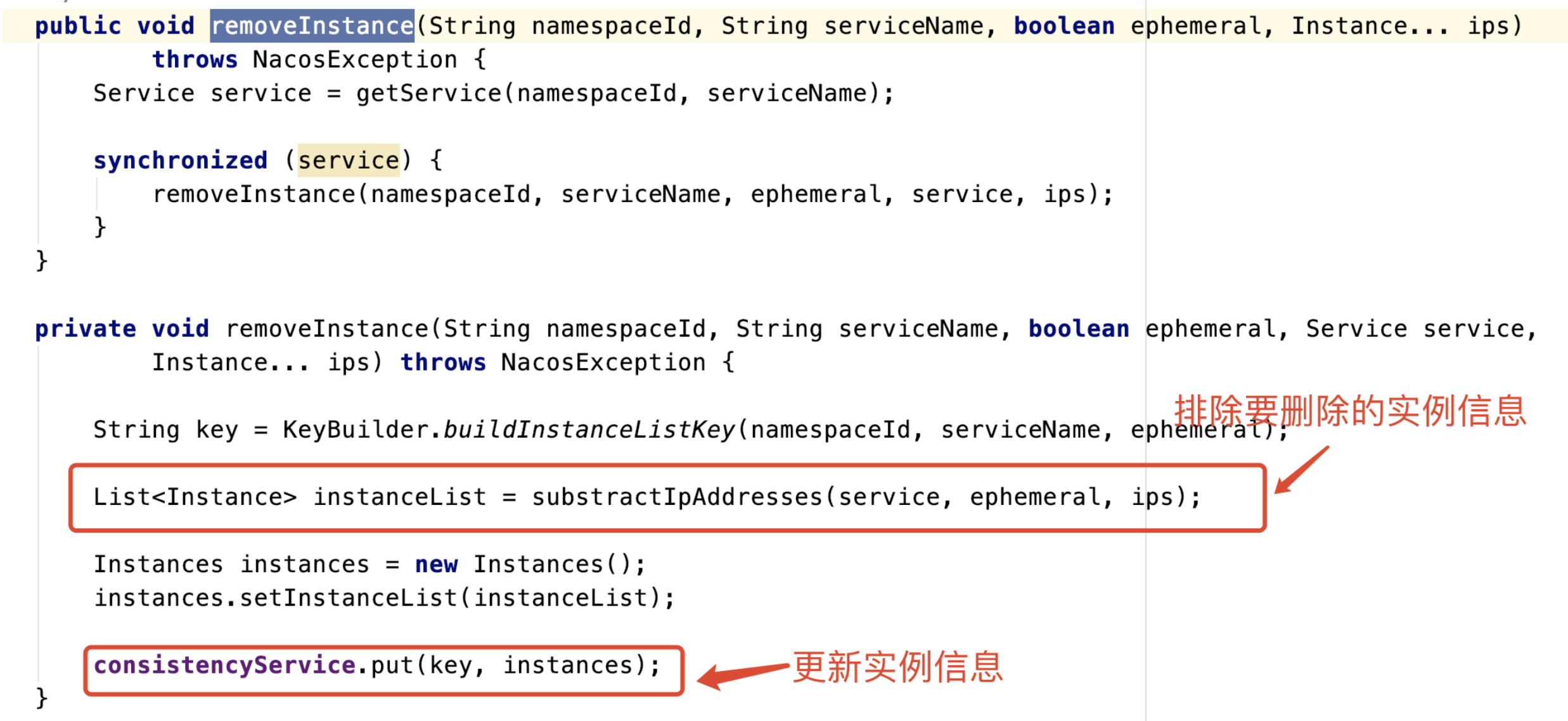
重点看下substractIpAddresses内部通过调用updateIpAddresses,该方法内部主要就是移除到超过30秒的实例信息,如下图:
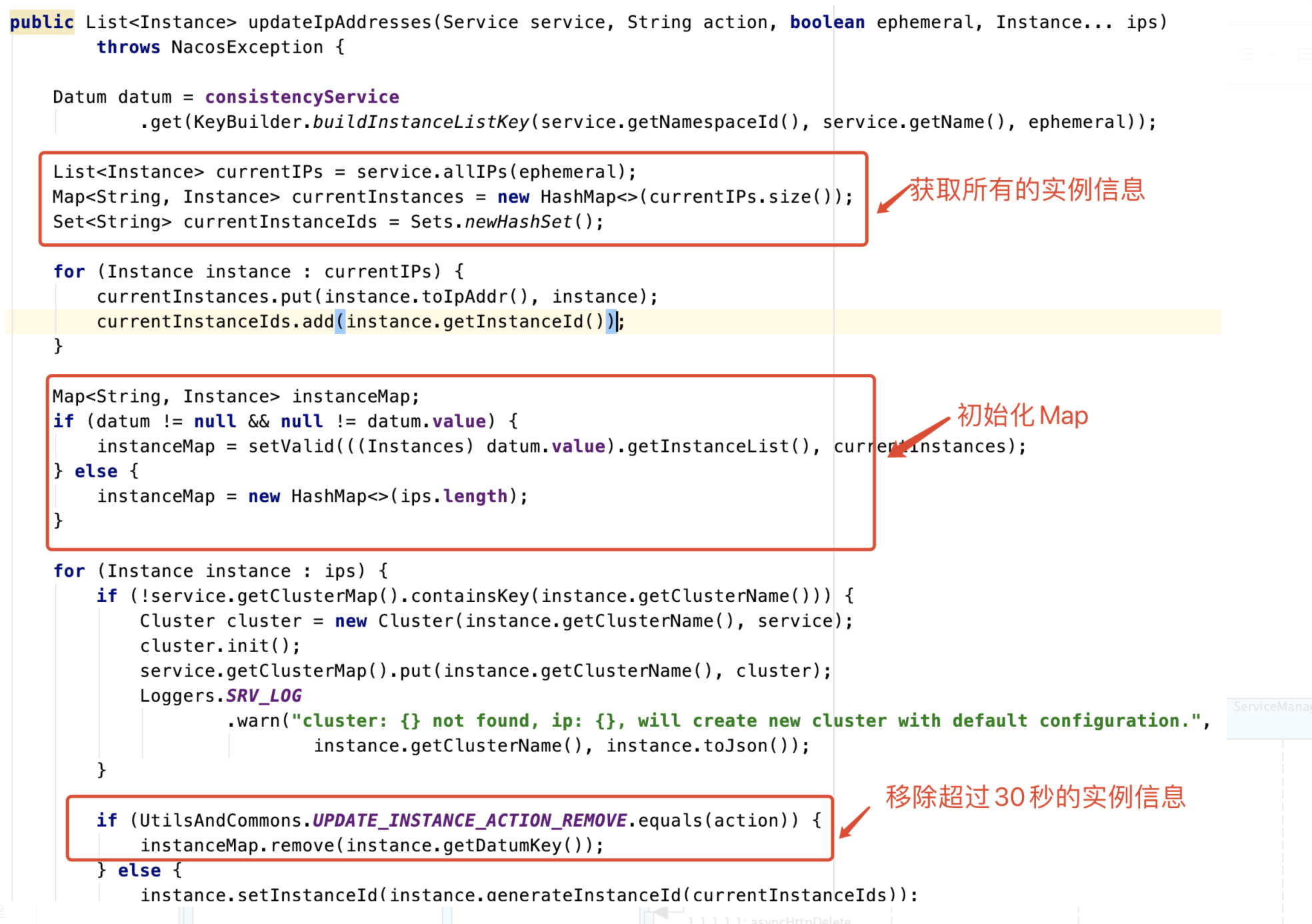
到此完成删除实例的过程,整体的时序图如下:

接下来我们看标记不健康时候的代码,这部分代码在客户端注册的时候也出现相同的代码,只是我们略过了,这部分也是观察者模式的重要体现,从这里我们可以学习到的东西在于结合Spring的事件机制,轻松实现观察者模式,当然这个里面也有部分我感觉写的不太好,哈哈,大佬们看到勿喷。

首先我们看serviceChanged方法,该方法主要是发布一个服务不健康的事件,如下图:

接下来我们看下如何处理这个事件,这个时候涉及PushService这个类,整体的继承结构如下图:

我们看到该类的继承ApplicationListener接口,该接口是一个支持泛型的接口,传入了ServiceChangeEvent的类,此处就是对事件的处理,如下图:

接下来看一下onApplicationEvent方法,这个方法主要完成了准备数据,发送数据这几件事情:

public void onApplicationEvent(ServiceChangeEvent event) { Service service = event.getService(); String serviceName = service.getName(); String namespaceId = service.getNamespaceId(); Future future = GlobalExecutor.scheduleUdpSender(() -> { try { Loggers.PUSH.info(serviceName + " is changed, add it to push queue."); //获取所有需要推送的客户端 ConcurrentMap<String, PushClient> clients = clientMap .get(UtilsAndCommons.assembleFullServiceName(namespaceId, serviceName)); if (MapUtils.isEmpty(clients)) { return; } Map<String, Object> cache = new HashMap<>(16); long lastRefTime = System.nanoTime(); for (PushClient client : clients.values()) { //超时的不删除跳过处理 if (client.zombie()) { Loggers.PUSH.debug("client is zombie: " + client.toString()); clients.remove(client.toString()); Loggers.PUSH.debug("client is zombie: " + client.toString()); continue; } Receiver.AckEntry ackEntry; Loggers.PUSH.debug("push serviceName: {} to client: {}", serviceName, client.toString()); String key = getPushCacheKey(serviceName, client.getIp(), client.getAgent()); byte[] compressData = null; Map<String, Object> data = null; if (switchDomain.getDefaultPushCacheMillis() >= 20000 && cache.containsKey(key)) { org.javatuples.Pair pair = (org.javatuples.Pair) cache.get(key); compressData = (byte[]) (pair.getValue0()); data = (Map<String, Object>) pair.getValue1(); Loggers.PUSH.debug("[PUSH-CACHE] cache hit: {}:{}", serviceName, client.getAddrStr()); } //准备UDP数据 if (compressData != null) { ackEntry = prepareAckEntry(client, compressData, data, lastRefTime); } else { ackEntry = prepareAckEntry(client, prepareHostsData(client), lastRefTime); if (ackEntry != null) { cache.put(key, new org.javatuples.Pair<>(ackEntry.origin.getData(), ackEntry.data)); } } Loggers.PUSH.info("serviceName: {} changed, schedule push for: {}, agent: {}, key: {}", client.getServiceName(), client.getAddrStr(), client.getAgent(), (ackEntry == null ? null : ackEntry.key)); //发送数据 udpPush(ackEntry); } } catch (Exception e) { Loggers.PUSH.error("[NACOS-PUSH] failed to push serviceName: {} to client, error: {}", serviceName, e); } finally { //发送完成删除 futureMap.remove(UtilsAndCommons.assembleFullServiceName(namespaceId, serviceName)); } }, 1000, TimeUnit.MILLISECONDS); //增加待推送的任务 futureMap.put(UtilsAndCommons.assembleFullServiceName(namespaceId, serviceName), future); }
接下里我们重点看下udpPush的方法,整个方法主要是通过一个Map对象来记录UDP请求,如果没收到就重试发送请求,整体如下:

private static Receiver.AckEntry udpPush(Receiver.AckEntry ackEntry) { if (ackEntry == null) { Loggers.PUSH.error("[NACOS-PUSH] ackEntry is null."); return null; } //如果大于最大的尝试次数 //移除发送的数据和待确认的key //失败推送的次数+1 if (ackEntry.getRetryTimes() > MAX_RETRY_TIMES) { Loggers.PUSH.warn("max re-push times reached, retry times {}, key: {}", ackEntry.retryTimes, ackEntry.key); ackMap.remove(ackEntry.key); udpSendTimeMap.remove(ackEntry.key); failedPush += 1; return ackEntry; } try { if (!ackMap.containsKey(ackEntry.key)) { totalPush++; } //记录UDP请求的返回信息 ackMap.put(ackEntry.key, ackEntry); udpSendTimeMap.put(ackEntry.key, System.currentTimeMillis()); Loggers.PUSH.info("send udp packet: " + ackEntry.key); //发送UDP请求 udpSocket.send(ackEntry.origin); ackEntry.increaseRetryTime(); //如果UDP没收到返回信息 每10秒尝试一下 GlobalExecutor.scheduleRetransmitter(new Retransmitter(ackEntry), TimeUnit.NANOSECONDS.toMillis(ACK_TIMEOUT_NANOS), TimeUnit.MILLISECONDS); return ackEntry; } catch (Exception e) { Loggers.PUSH.error("[NACOS-PUSH] failed to push data: {} to client: {}, error: {}", ackEntry.data, ackEntry.origin.getAddress().getHostAddress(), e); ackMap.remove(ackEntry.key); udpSendTimeMap.remove(ackEntry.key); failedPush += 1; return null; } }
服务端有发送,那么客户端就有接收的,接收部分我理解上是服务发现部分,这里我们就不做过多介绍,待下一篇再来聊聊。
结束
欢迎大家点点关注,点点赞,感谢!

